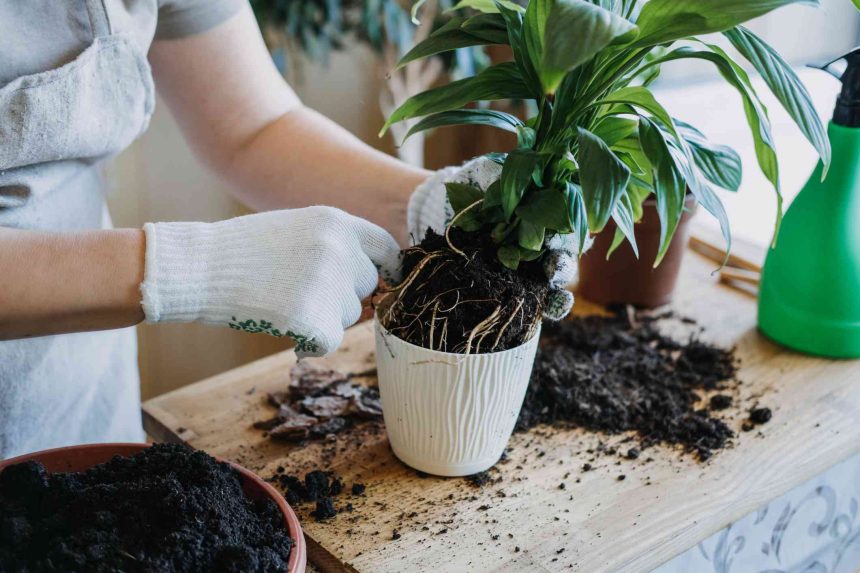Peace lilies are low-maintenance houseplants for various reasons. They grow moderately fast, so they only need to be repotted every two to three years. Repotting your peace lily in fresh potting soil and a larger pot as needed is key to keeping the plant healthy and developing its long-lasting flowers every spring (and to bloom a second time in the fall in ideal conditions).
Learn how to determine whether your peace lily needs repotting, when to do it, and how with these step-by-step instructions.
gadost / Getty Images
When to Repot a Peace Lily
Peace lilies reach maturity in about three years, which is when the plants usually start to flower. Repotting is necessary every two years but that’s not a hard-and-fast number because depending on the growing conditions, your plant may grow slower or faster. Also, peace lilies are one of the houseplants that do well when they are slightly root-bound.
Instead of taking the two-year rule literally, read the signs that a peace lily requires repotting. These include:
- Stems that are outgrowing the pot
- Roots that are emerging from the soil surface or the drainage holes
- A soil surface that is crusty and compacted and no longer lets water seep through
- Yellow leaves, which are likely to occur if you haven’t repotted your plant in a couple of years. This indicates an exhausted potting medium that needs to be replaced with fresh, nutrient-rich soil.
If you observe any of the above conditions, it’s time to repot your peace lily. The ideal time for repotting is at the beginning of the most active growth period in the early spring, around March.
Repotting the plant later in the season is still possible, however, avoid repotting in the middle of winter. Peace lilies don’t have a dormancy period, but plant growth slows down, and repotting during that time makes it harder for the plant to recover afterward.
gadost / Getty Images
Want more gardening tips? Sign up for our free gardening newsletter for our best-growing tips, troubleshooting hacks, and more!
How to Repot a Peace Lily
Follow these instructions to properly repot your peace lily:
- Water your peace lily in its old pot a couple of hours before repotting, which helps loosen the soil and the root system.
- Use a pot that is only 1 to 2 inches larger in diameter than the old pot or the root ball of the plant, and make sure it has large drainage holes.
- Place a layer of fresh, well-draining potting mix in the bottom of the pot. Any high-quality potting mix for houseplants will do the job.
- Carefully remove the plant from its old pot. If necessary, tap the sides to loosen it. Turning the pot on its side can also help to dislodge it. Don’t aggressively pull on the plant or the roots, which risks damaging them.
- Inspect the roots and remove any damaged or rotting roots with clean, sharp pruning shears.
- Center the plant in the new pot so the top of the root ball is 1 to 2 inches below the rim of the new pot. If the plant sits too low in the pot, add more potting mix to the base of the pot to raise it.
- Fill in the potting mix around the root ball and gently tap it down to remove any air pockets.
- Water the plant slowly and deeply. Place it in a location away from direct, harsh sunlight.
- Keep an eye on the plant for the first few days after repotting to catch any signs of repotting shock. Water again when the top of the soil has dried out.
- After about a week, if the plant does not show any repotting shock, move it to its permanent location in filtered sun or an east-facing window.
gadost / Getty Images
How to Prevent and Treat Peace Lily Repotting Shock
The sudden change in its environment due to repotting may cause your peace lily to show signs of repotting shock, also known as transplant shock.
To prevent repotting shock, repot your plant at the right time (early spring) and be very gentle when handling the roots, as damaged roots have difficulty taking up water and nutrients, which causes wilting and drooping.
If your peace lily shows repotting shock, give it time to adjust. Make sure not to overwater it, fertilize it, and keep it out of direct sunlight, all of which cause additional stress for the plant.
FAQ
-
Yes, a droopy peace lily after being repotted is usually temporary and the plant fully recovers, provided it has been repotted properly.
-
The potting soil to use for a peace lily should contain plenty of organic matter—this mimics the plant’s rainforest habitat where the soil is rich in decomposing plant material.
-
It may take a peace lily one to two weeks after repotting to recover from limp leaves and droopy stems. The plant growth may initially also slow down after repotting.






